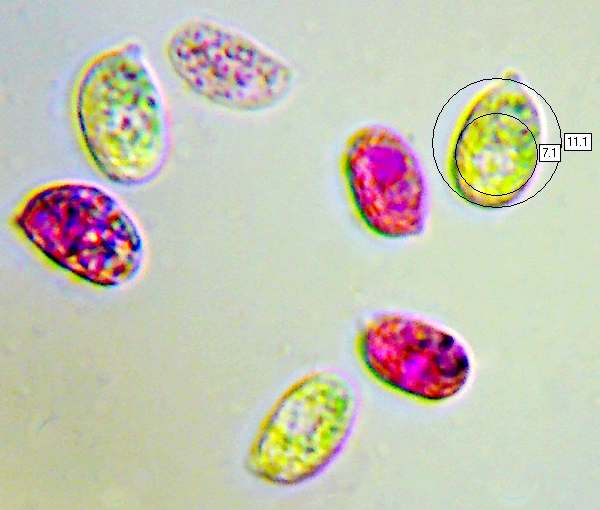Mycena vitilis (Fr.) Quel. - Snapping Bonnet
Phylum: Basidiomycota - Class: Agaricomycetes - Order: Agaricales - Family: Mycenaceae
Distribution - Taxonomic History - Etymology - Identification - Culinary Notes - Reference Sources
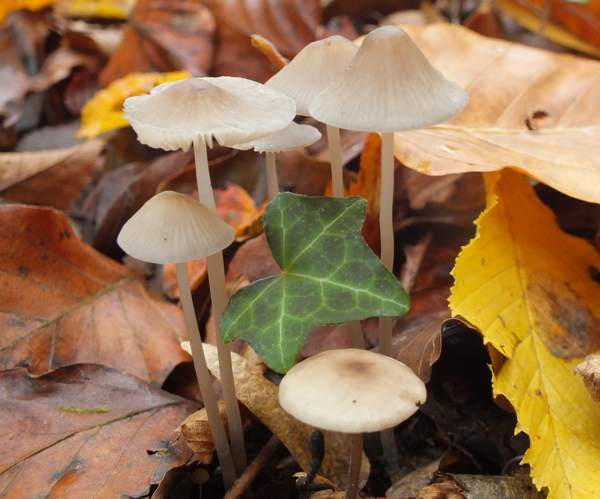
There are numerous little grey-brown bonnet mushrooms and they are much easier to find than to identify, generally requiring microscopic examination of spores, cap cell structure and gill cystidia.
The Snapping Bonnet looks very similar to many other small bonnet fungi, but it sounds rather different: when its stem is pulled lengthways it breaks with a sharp snapping sound - hence the common name Snapping Bonnet. .
Distribution
Sometimes appearing singly but more often in small scattered groups of two or three fruitbodies, the Snapping Bonnet is found throughout Britain and Ireland and is common also in many parts of mainland Europe, particularly in northern and central countries. This little bonnet mushroom occurs in many other parts of the world including North America.
Taxonomic history
Swedish mycologist Elias Magnus Fries described the Snapping Bonnet in 1838, giving it the binomial scientific name Agaricus vitilis. It was a Frenchman, Lucien Quélet, who in 1872 transferred this species to its present genus, thus establishing its currently-accepted scientific name Mycena vitilis.
Synonyms of Mycena vitilis include Mycena filopes and Agaricus vitilis Fr.
Etymology
The specific epithet vitilis means 'plaited' or 'good for tying with', which I take to be a reference to the flexibility of the stems.
Identification guide
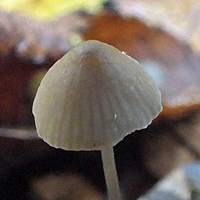 |
Cap0.5 to 1.8cm (but usually <1cm) in diameter; conical, becoming bell shaped and eventually sometimes flattening with an umbo; smooth with marginal lines corresponding to the gills; various shades of beige or greyish brown, usually paler near the margin. The cap surface is pruinose at first but soon becomes smooth; shiny when dry and sticky when wet. |
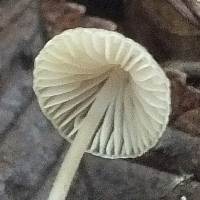 |
GillsAdnexed to almost free; whitish. Gill edges are very finely serrate. Stem6 to 12cm long and 1.5 to 2mm in diameter; various shades of brownish grey sometimes with a pinkish tinge; smooth with a slightly greasy feel, but woolly at the stem base; no stem ring. Stems are flexible and can be bent significantly without breaking. When stretched the stem breaks with an audible 'snap'. |
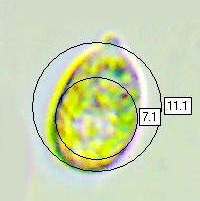 |
SporesEllipsoidal, smooth, 9-12.2 by 5-6 μm; hyaline, amyloid. Spore printWhite. |
CheilocystidiaUp to 50µm in length (exceptionally to 70µm), irregularly claviform (club-shaped) with one or more apical extensions. PleurocystidiaAbsent. |
|
Odour/taste |
Not significant. |
Habitat & Ecological role |
Saprobic. Look out for these neat little mushrooms in deciduous broadleaf woodlands or in mixed woodlands, where the long stems are usually attached to buried twigs or bark. |
Season |
July to November in Britain and Ireland. |
Similar species |
Mycena galopus is similar (but often larger); it releases white latex when the stem is broken. |
Culinary notes
These little fungi are far too small and insubstantial to be of culinary interest. It is unclear whether they are toxic or not.
Reference Sources
Fascinated by Fungi, 2nd Edition, Pat O'Reilly 2016, reprinted by Coch-y-bonddu Books in 2022.
Penny Cullington, (Oct. 2013). British Mycenas - Brief Descriptions.
Giovanni Robich, (2003). Mycena d'Europa; Associazione Micologica Bresadola ; Vicenza : Fondazione Centro Studi Micologici.
British Mycological Society. English Names for Fungi
Dictionary of the Fungi; Paul M. Kirk, Paul F. Cannon, David W. Minter and J. A. Stalpers; CABI, 2008
Taxonomic history and synonym information on these pages is drawn from many sources but in particular from the British Mycological Society's GB Checklist of Fungi.
Fascinated by Fungi. Back by popular demand, Pat O'Reilly's best-selling 450-page hardback book is available now. The latest second edition was republished with a sparkling new cover design in September 2022 by Coch-y-Bonddu Books. Full details and copies are available from the publisher's online bookshop...
